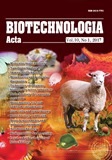"Biotechnologia Acta" V. 10, No 1, 2017
https://doi.org/10.15407/biotech10.01.061
Р. 61-67, Bibliography 17, English
Universal Decimal Classification: 577.112:616.128

PT (II) AND PD (II) COMPLEXES INFLUENCE ON SPHEROIDS GROWTH OF BREAST CANCER CELLS
A. A. Bilyuk 1, O. V. Storozhuk 1, O. V. Kolotiy 1, H. H. Repich 2, S. I. Orysyk 2, L. V. Garmanchuk 1
1 Educational and Scientific Centre “Institute of Biology and Medicine” of Taras Shevchenko National University of Kyiv, Ukraine
2 Vernadskyi Institute of General and Inorganic Chemistry of the National Academy of Sciences of Ukraine, Kyiv
The aim of the research was to examine the changes in multi-cellular tumor spheroid growth, adhesion properties and gamma-glutamintranspeptidasic activity in model systems of human breast cancer multicellular spheroid MCF-7 under the influence of Pt(ІІ) and Pd(ІІ) π-complexes with allyl-containing thioureas. Comparing with cisplatin, Pt(II) and Pd(II) complexes reduce gamma-glutamintranspeptidasic activity, increase adhesive properties in model system of solid tumor and inhibit the multicellular spheroids’ growth. All changes prove the importance of further investigation and analysis of these compounds as potential analogues of anticancer drugs that possibly do not cause resistance and reduce the level of metastasis in breast cancer.
Key words: Pt(ІІ) and Pd(ІІ) π-complexes, gamma-glutamintranspeptidase, adhesive properties, multi-cellular tumor spheroids.
© Palladin Institute of Biochemistry of National Academy of Sciences of Ukraine, 2017
References
1. Rosenberg B., Van Camp L., Trosko J. E., Mansour V. H., Platinum compounds: a new class of potent antitumor agents. Nature. 1969, V. 222, P. 385–686. https://doi.org/10.1038/222385a0
2. Aoki K., Murayama K. Nucleic acid-metal ion interactions in the solid state. Met. Ions Life Sci. 2012, V. 10, P. 43–102. doi: 10.1007/978-94-007-2172-2_2. https://doi.org/10.1007/978-94-007-2172-2_2
3. Kelland L. The resurgence of platinum-based cancer chemotherapy. Nat. Rev. Cancer. 2007, V. 7, P. 573–584. https://doi.org/10.1038/nrc2167
4. Frezza M., Hindo S., Chen D., Davenport A., Schmitt S., Tomco D.. Dou Q. P. Novel metals and metal complexes as platforms for cancer therapy. Curr. Pharm. Des. 2010, V. 16, P. 1813–1825. PMID: 20337575. https://doi.org/10.2174/138161210791209009
5. Repich H. H., Orysyk V. V., Palchykovska L. G., Orysyk S. I., Zborovskii Yu. L., Vasylchenko O. V., Storozhuk O. V., Biluk A. A., Nikulina V. V., Garmanchuk L. V., Pekhnyo V. I., Vovk M. V. Synthesis, spectral characterization of novel Pd(II), Pt(II) ?-coordination compounds based on N-allylthioureas. Cytotoxic properties and DNA binding ability. J. Inorg. Biochem. 2017, https://www.scopus.com/sourceid/17615?origin=recordpageV. 168, P. 98–106. https://doi.org/10.1016/j.jinorgbio.2016.12.004
6. Che C. M., Siu F. M. Metal complexes in medicine with a focus on enzyme inhibition. Curr. Opin. Chem. Biol. 2010, V. 14, P. 255–261.https://doi.org/10.1016/j.cbpa.2009.11.015
7. Gasser G., Ott I., Metzler-Nolte N. The potential of organometallic complexes in medicinal chemistry. J. Med. Chem. 2011, V. 54, P. 3. https://doi.org/10.1016/j.cbpa.2012.01.013
8. Sedletska Y., Giraud-Panis M. J., Malinge J. M. Cisplatin is a DNA-damaging antitumour compound triggering multifactorial biochemical responses in cancer cells: importance of apoptotic pathways. Curr. Med. Chem. Anticancer Agents. 2005, V. 5, P. 251–265. PMID: 15992353. https://doi.org/10.2174/1568011053765967
9. Kartalou M., Essigmann J. M. Mechanisms of resistance to cisplatin. Mutat. Res. 2001, V. 478, P. 23–43. PMID: 11406167. https://doi.org/10.1016/S0027-5107(01)00141-5
10. Brozovic A., Ambriovi?-Ristov A., Osmak M. The relationship between cisplatin-induced reactive oxygen species, glutathione, and BCL-2 and resistance to cisplatin. Crit. Rev. Toxicol. 2010, 40 (4), 347–359. https://doi.org/10.3109/10408441003601836
11. Pearson R. G. Antisymbiosis and the trans effect. Inorg. Chem. 1973, 12 (3), 712–713. https://doi.org/10.1021/ic50121a052
12. Kim J. B. Three-dimensional tissue culture models in cancer biology. Semin Cancer Biol. 2005, V. 15, P. 365–377. PMID: 15975824. https://doi.org/10.1016/j.semcancer.2005.05.002
13. Girard Y. K., Wang C., Ravi S., Howell M. C., Mallela J. et al. A 3D fibrous scaffold inducing tumoroids: a platform for anticancer drug development. PLoS One. 2013, V. 8, P. e75345. doi: 10.1371/journal.pone. 0075345 PMID: 24146752.
14. McMahon K. M., Volpato M., Chi H. Y., Musiwaro P., Poterlowicz K. et al. Characterization of changes in the proteome in different regions of 3D multicell tumor spheroids. J. Proteome Res. 2012, V. 11, P. 2863–2875. https://doi.org/10.1021/pr2012472
15. Huang S. G., Zhang L. L., Niu Q., Xiang G. M., Liu L. L. et al. Hypoxia Promotes Epithelial—Mesenchymal Transition of Hepatocellular Carcinoma Cells via Inducing GLIPR-2. Expression. PLoS One. 2013, V. 8, P. e77497. https://doi.org/10.1371/journal.pone.0077497
16. Gallardo-P?rez J. C., Rivero-Segura N. A., Mar?n-Hern?ndez A., Moreno-S?nchez R., Rodr?guez-Enr?quez S. GPI/AMF inhibition blocks the development of the metastatic phenotype of mature multi-cellular tumor spheroids. Biochim. Biophys. Acta. 2014, V. 1843, P. 1043–1053. https://doi.org/10.1016/j.bbamcr.2014.01.013
17. Burstein H. J., Schwartz R. S. Molecular origins of cancer. New Engl. J. Med. 2008, 358 (5), 527, 2039–2049. https://doi.org/10.1056/NEJMe0800065

